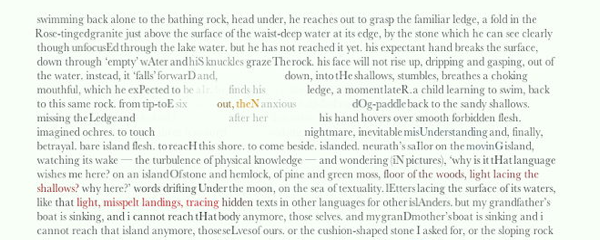
Misspelt Landings
You may download a simple runnable jar, here:
Misspelt Landings.
The text constituting the surface of Misspelt Landings is a prose poem by John Cayley. Three readers are released onto the surface of this text. One of these readers is a neighbor-showing Perigram Reader, one is a haloing Unconstrained Perigram Reader, and one is a jumping Mesostic Reader.
When Misspelt Landings runs, an early version of a neighbor-showing Perigram Reader (in red) sets out from the beginning of the text. Meanwhile, the haloing, Unconstrained Perigram Reader (ochre) starts reading a few lines below. They move at different speeds and with different inclinations. The Perigram Reader moves quite steadily rightwards and downwards, although deviating occasionally from the now western-conventional linear reading path. Speed and inclination are parameters of these readers that may be set programmatically. As they read, Perigram Readers 'show' the words in their typographic neighborhood words by revealing them in a shade of grey. A word is a neighbor if it is contiguous with a reader although it may be considered a neighbor if a word is typographically 'distant' but (potentially) about-to-be-read. Hence, a word on the left margin or top line may be a leading neighbor of a reader when this reader has reached the right-most or bottom-most position in a block of text. Perigram Readers may be deflected from the usual linear reading path if the word currently being read and one of its leading neighbors on the lines above or below is deemed to be part of a natural language 'perigram' (a natural language collocation) in the language of the text. Depending on a reader's pre-set parameters it will have a greater or lesser tendency to read through these alternate perigrams. This explains the variability of a Perigram Reader's path through the text. The Perigram Readers display the words they are reading in a set color and show their neighbors in grey. After they have passed on, these colors slowly fade to the background, leaving a trail of indeterminate length.
The haloing, Unconstrained Perigram Reader (ochre) is also sensitive to the perigrams in its neighborhood, but it is quite likely to move up, or back to the left, or even down and to the left. Thus, it wanders a little more freely and gets caught in eddies of repeated perigrammatically linked phraseology. As it reads, it fades out the more distant neighbors of its immediate neighbors, creating its characteristic halo and focusing our human attention on its central meandering fixations.
The jumping Mesostic Reader displays the words it reads in blue. This reader looks for words containing specific letters which, once found, it emphasizes by making them upper case. The jumping Mesostic Reader that reads through Misspelt Landings spells and respells the following phrase: 'reading through landings through spelling through misspellings through,' letter by letter, 'R-E-A-D- ...' and so on, repeatedly. The Perigram Reader and its Unconstrained haloing cousin undo the Mesostic Reader's capitalizations as and when they read or reread a word that the Mesostic Reader has previously read.
This runnable jar was - as for the original development environment of The Readers Project - written and generated using Processing and RiTa, the extensive natural language processing and text handling libraries for Processing by Daniel C. Howe. These now support Javascript with the same api.
Misspelt Landings was one of the first works to emerge from The Readers Project. It was originally offered as a Java Applet, but lack of support from Big Software has had the consequence that this mode of distribution is unreliable. This runnable jar is provided for archive purposes and as an interim measure only.
An earlier version of Misspelt Landings was first performed for the Literary Extravaganza of the DAC Conference, UC Irvine, Dec 12-15, 2010, and this version of the Applet was made available at the associated site.